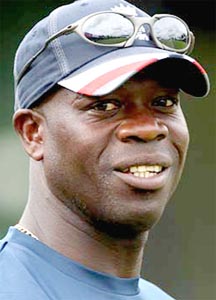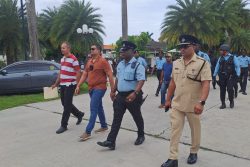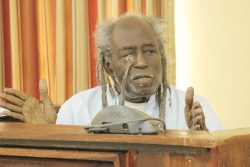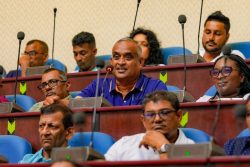By Tony Cozier At the ICC World Cup In CHANDIGARH
They wore the maroon of the West Indies as team mates in nine One-Day Internationals in Sharjah and Australia in the mid-1990s but Ottis Gibson and Phil Simmons were in different colours and in different roles at the Punjab Cricket Association Stadium in the Mohali district of this northern Indian city today (overnight south Caribbean time).
Their immediate task was to direct their teams in a key group stage World Cup match, Gibson still in maroon as West Indies head coach, Simmons in green as his counterpart for Ireland.
Victory would place either close to a place in a knockout, quarter-final after which anything is possible. But they both know full well the pitfalls confronting sporting teams that get ahead of themselves.
They had already stated that they are taking it one match at a time, in spite of the West Indies’ pitiless thumping of Bangladesh in Dhaka a week earlier and Ireland’s startling upset victory previously over England. They appreciate that, given their teams’ limitations, record and ODI rankings, they are unlikely to be guzzling champagne when the captain lifts the Cup after the final in Mumbai’s Wankhede Stadium on April 2.
That will more likely be by an Australian, Indian, Sri Lankan or South African.
To aim for the glory of the championship was not a realistic goal for one team ranked No.9, as the West Indies were, and another, Ireland, No.10 among the 14 participants.
Gibson would go no further than state, from the start, that the West Indies could surprise those doubters who looked at their recent record (12 defeats against four wins over the past year) and dismissed them as genuine contenders.
He was more intent on using cricket’s foremost tournament to rebuild a team, down in the dumps for more than a decade, that could genuinely challenge for the next World Cup in Australia and New Zealand four years hence. This was to be just the stepping stone.
 Simmons’ mission was even less ambitious in terms of this tournament. It was simply to prove that Ireland fully deserved its continuing status as the top associate nation, as it has been since it toppled Pakistan to advance to last eight in the Cup in the Caribbean four years ago.
Simmons’ mission was even less ambitious in terms of this tournament. It was simply to prove that Ireland fully deserved its continuing status as the top associate nation, as it has been since it toppled Pakistan to advance to last eight in the Cup in the Caribbean four years ago.
The International Cricket Council (ICC) revelation that the next tournament will be trimmed to ten teams was further incentive. By overcoming England, running Bangladesh close and pressing India hard, they have made their point. The West Indies’ scalp would reinforce it.
Apart from their West Indies’ links, Gibson and Simmons have taken similar paths to their present positions. Gibson moved on from Barbados to several seasons as fast bowler/strong lower order batsman in provincial South African and English county cricket.
He signed off as an active player in spectacular fashion with Durham in 2008, the last bowler to claim all 10 wickets in an innings and with a Wisden Cricketer of the Year title to add to his c.v.
Settled in England and accredited as a grade one coach, he moved immediately to be their bowling coach, doing a Simmons in reverse as he was on the opposite side on England’s 2009 series in the Caribbean and the brief, return series at home.
All along, his desire was for the West Indies post. He saw the fact that no previous coach had lasted more than two years not as a deterrent but as a challenge.
His appointment came in 2009 when John Dyson, the second successive Australian in the position, was dismissed following the loss to Bangladesh in the home series by a team decimated by the strike of leading players.
If there were any doubts about the size of the problems that lay ahead, they were soon erased by ODI whitewashes from Australia, South Africa and, most recently, Sri Lanka.
Yet Gibson kept insisting that several of the results were close and that the West Indies possessed the talent to pull themselves out of the deep hole into which they had sunk. Commitment and self-belief were all that was needed to be restored.
He is a strong character, not about to abide nonsense within the team or from outside.
When Haroon Lorgat, chief executive of the ICC no less, dismissed the stoning attack on the West Indies’ bus after their win over Bangladesh as the tossing of “pebbles”, he upbraided him in the same strong language he uses to players who do not measure up.


Like Gibson, Simmons spent several seasons in the English county championship. As punishing opening batsman, useful medium-pace bowler and bucket-hands catcher, he was outstanding for Leicestershire, like Gibson climaxing his playing days as a Wisden Cricketer of the Year award after an outstanding season.
He also became a qualified top flight coach. A brief stint with a dysfunctional Zimbabwe administration ended with them going their separate ways.
His signing by Ireland following the 2007 World Cup has been altogether happier, his contract recently extended to the end of 2011. It may even go longer. He is a massive man with the intimidating build of a heavyweight champion.
Yet his Irish players describe him as calm and relaxed, almost gentle in his dealings with them. When they were going after an unlikely score of 328 to beat England, fast bowler Boyd Rankin described him as “a laidback guy…a perfect man to have in such situations”.
“He constantly reassured us that the target was within reach and it could easily be managed,” he said.
That was all very well. It is what most coaches would have come up with in the circumstances. The point was that his players unreservedly believed him.
It is conviction that Gibson is also beginning to achieve with the West Indies.









